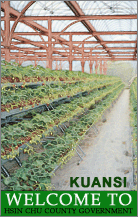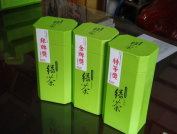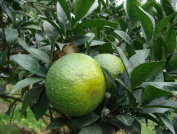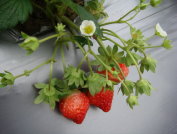Featured Industries and Products of Townships-Guanxi Town

Guanxi Township

Nestled among mountains on three sides, Guanxi is traversed by the Fengshan River. Its river terraces at the confluence of Niulan and Fengshan Rivers form a key junction linking the northeastern hills of Hsinchu to both north–south and east–west routes. Since the opening of National Highway No. 3, Guanxi’s accessibility has improved further, spurring growth in its leisure and tourism sectors. Large-scale developments—golf courses, themed parks, and holiday resorts—on its expansive hillsides have made Guanxi the township with the highest density of golf courses in Taiwan. Guanxi is also celebrated as a “Town of Longevity.”

Tea
Rolling tea plantations are a hallmark of Guanxi’s landscape, especially in Dongping and Ren’an villages, where Pouchong and green teas dominate. Mild, misty weather, abundant rainfall, and well-drained soils create ideal conditions for tea cultivation. During Japanese rule, Taiwan tea was prioritized for export—Guanxi’s tea gardens expanded to 46,000 ha at their peak. In 1935, Guanxi tea won top honors in a national popularity poll. To meet export demand, local leader Luo Biyu and other investors founded Taiwan Red Tea Co. in 1937, establishing the region’s first tea processing plant and building an international brand. After 1945, green tea exports took precedence; by 1949, 6,000 ha of Guanxi tea gardens were shipping 500 mt annually. While global competition and rising costs have since reduced plantation area, recent government programs are helping farmers and factories modernize processing and improve quality. Today, Guanxi promotes premium green tea through annual taste tests and grading competitions to guarantee consumer quality and boost farmer incomes.

Citrus
Belonging to the Rutaceae family, citrus trees thrive in Taiwan’s subtropical lowlands. Guanxi’s 534 ha of orchards—mainly in Jinshan, Jinshan, Shanglin, Nanhe, Xinfu, Xinli villages—benefit from gentle hills, 22–23 °C average temperatures, and rich, well-drained soil. Varieties include Ponkan, grapefruit, tangerine, and mandarins, with “Haili Mandarin” the most widely planted. Seven production teams coordinate harvest and marketing.

Strawberries
Strawberry seedlings are raised from April to September and planted around Mid-Autumn Festival, entering full harvest by late November. The six-month harvest season features four peak periods, with the sweetest, largest berries appearing December through February. Guanxi’s 18 ha of strawberry fields, planted along County Routes 118 and the Provincial Highway 3, are the largest in the county. Many farms use soilless “plug” and hydroponic methods for larger, sweeter fruit. Some hold the “GAP Safe Produce” certification, ensuring pesticide-free picking. Guanxi’s berries have even starred in a national telecom advertisement showcasing pesticide-free freshness.
No. 10, Guangming 6th Rd., Zhubei City, Hsinchu County 302099 03-551-9041 03-551-9339
Copyright 2024 Industrial Commercial Development & Investment Promotion Committee All Rights Reserved.